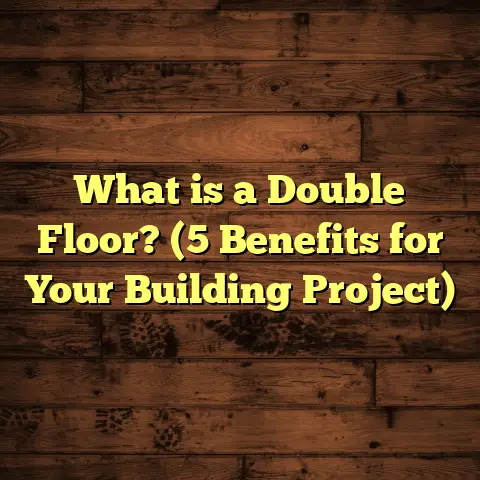What is Epoxy Flooring? (5 Benefits for Your Space Revealed)
Modern aesthetics have shifted the way we think about floors. Back when I first started in flooring, floors were mostly something you looked past — a practical surface that did its job. Today, floors add character, style, and even influence the feel of a room. Over the years, one flooring solution I’ve come to appreciate and recommend a lot is epoxy flooring. It’s tough, stylish, and surprisingly versatile. If you’re considering options for your space, you might be wondering: what exactly is epoxy flooring? How does it work? And more importantly, what benefits could it bring to your home or business? Let me share what I’ve learned from years of hands-on experience and research.
What is Epoxy Flooring?
At its core, epoxy flooring is a type of surface coating made by combining epoxy resin with a hardener. When these two materials mix, they undergo a chemical reaction that creates a rigid, plastic-like material that bonds tightly to the floor beneath it—usually concrete. This bonding creates a smooth, shiny surface that’s incredibly durable and resilient.
I remember my first encounter with epoxy flooring clearly. It was on a client’s garage renovation. The concrete floor was stained and cracked, and they wanted something that would not only look good but also hold up against oil drips and heavy tools. We applied an epoxy coating—a process that took about three days—and by the end, the floor looked brand new, with this glossy finish that reflected the overhead lights beautifully.
Epoxy coatings usually range from 2 to 3 millimeters thick—thin enough that it doesn’t add bulk but thick enough to protect the floor underneath. The exact thickness can depend on the type of epoxy used and the application method.
How is Epoxy Flooring Applied?
To give you an idea of the process, here’s how an average epoxy flooring installation goes:
- Surface preparation: This is key. The concrete must be cleaned thoroughly, cracks filled, and sometimes roughened using acid etching or grinding so the epoxy can adhere properly.
- Priming coat: A primer layer is applied to seal the concrete and improve adhesion.
- Base coat: This is the main epoxy mixture applied evenly.
- Decorative layer: Optional flakes, chips, or metallic pigments can be embedded here for texture and style.
- Topcoat: A clear protective layer seals everything.
Each step requires drying or curing time—usually between 12 to 24 hours per coat—so expect around 2 to 4 days for completion on an average residential project.
Where Is Epoxy Flooring Used?
Epoxy flooring was initially popular in industrial settings like warehouses and factories because of its durability. Over time, it has expanded into garages, commercial kitchens, hospitals, retail spaces, and even homes.
In industrial warehouses, floors can span thousands of square feet. For instance, a 10,000-square-foot warehouse might take a week or more to complete depending on prep work. The cost for such large projects averages around $4 to $7 per square foot, often lower than smaller residential jobs due to scale.
Residential garage floors typically range from $3 to $12 per square foot, influenced by factors like floor condition, color choices, decorative options (like metallic finishes or flakes), and local labor rates.
5 Benefits of Epoxy Flooring for Your Space
I’ve seen firsthand how epoxy flooring can transform a room not just visually but functionally. Here are five benefits that stand out most.
1. Durability That Withstands Heavy Use
One of the biggest reasons I recommend epoxy flooring is its toughness. I’ve worked on commercial warehouses where forklifts and pallets roll over the floor every day. After years of use, the epoxy coating still looks intact with no cracks or chips.
Epoxy forms a hard shell over concrete that resists:
- Impacts
- Abrasion
- Chemical spills
- Stains
To put this in perspective, standard concrete floors have a compressive strength of around 3,000 psi (pounds per square inch). Epoxy coatings add a protective layer that boosts resistance against surface wear and tear. Some heavy-duty epoxies can resist chemical spills like oil or solvents for up to 10 years, which is why they’re common in automotive workshops.
One project I remember well was for a manufacturing plant that wanted a floor resistant to corrosive chemicals used in production. We installed a chemical-resistant epoxy with multiple coats totaling about 4 mm thick. The client reported zero damage after two years despite daily exposure.
2. Easy Maintenance Saves Time & Money
If you’re tired of spending hours scrubbing floors or dealing with stains that won’t budge, epoxy’s ease of maintenance will be a relief.
Unlike carpets or wood that require special cleaners and treatments, epoxy floors clean up with simple sweeping and mopping. Dust and dirt don’t stick to the surface, and spills wipe right off before they set in.
For example, a restaurant I worked with switched their kitchen floors from tile—which absorbed grease and became slippery—to epoxy coated with an anti-slip additive. Not only did cleaning time drop by about 40%, but staff felt safer working there.
From my experience with clients managing commercial spaces, maintenance costs drop by roughly 30% annually after switching to epoxy floors compared to traditional tiles or vinyl.
3. Customizable Aesthetic Options
Epoxy isn’t just plain gray or white anymore. You can pick from hundreds of colors and finishes to match your style or brand.
You want a glossy blue floor with silver flecks? No problem. Prefer a matte finish with earth tones? That’s doable too. Some epoxies even mimic natural stone or marble with metallic pigments.
I helped design a showroom floor using metallic epoxy with swirling patterns—it looked like polished stone but was far more durable and easier to clean.
Because the coating is seamless—without grout lines or joints—it can make small rooms feel bigger by reflecting light evenly across the surface.
4. Safety Features: Slip Resistance & Hygiene
Safety is often overlooked when choosing floors but it shouldn’t be. Epoxy coatings can be mixed with anti-slip additives like quartz sand or aluminum oxide to improve grip—essential in wet or oily environments.
Studies show floors treated with anti-slip epoxy reduce slip-and-fall accidents by up to 50% in industrial settings. I’ve installed such coatings in hospitals and food processing plants where safety regulations are strict.
Another plus is hygiene—because epoxy surfaces are seamless and non-porous, they don’t harbor bacteria or mold like grout lines in tile floors can. This makes them perfect for places needing strict cleanliness standards like clinics or commercial kitchens.
5. Long-Term Cost Effectiveness
While some people hesitate at epoxy’s upfront cost (usually $3-$12 per square foot), it’s important to consider its lifespan and durability which translate into savings later.
A case study from a manufacturing company I reviewed showed switching from vinyl to epoxy resulted in:
- 30% reduction in repair & maintenance costs over five years
- Reduced downtime for floor repairs
- Less frequent replacement cycles
Epoxy floors typically last 10-20 years when maintained properly—a solid investment compared to tile or carpet which often need replacement every 5-10 years depending on use.
My Personal Stories & Lessons Learned
Over the years, I’ve installed epoxy floors in all sorts of places—each project teaching me something new about what works best.
One memorable job was at a family-run brewery. They wanted floors that handled constant moisture, spilled beer, foot traffic from patrons, and heavy storage racks—all while maintaining a polished look for tours.
We chose a high-performance epoxy with an anti-slip additive for safety and applied decorative flakes for visual interest. The entire 800-square-foot floor took four days including prep and curing time.
Months later, the owners told me how they appreciated how easy it was to clean sticky spills and how their staff felt confident walking around even when wet areas formed.
Another time, I helped a homeowner turn their basement into a home gym with cushioned epoxy flooring designed for impact resistance. They loved how it felt underfoot compared to rubber mats—durable yet comfortable.
These experiences taught me that epoxy isn’t one-size-fits-all; different formulations suit different needs—whether you want glossy beauty or rugged functionality.
Deep Dive: Data & Research on Epoxy Flooring Performance
I like backing up my recommendations with real data:
- Thickness & durability: Typical commercial-grade epoxies are between 2-5 mm thick; thicker layers increase impact resistance but cost more.
- Hardness rating: Epoxy hardness is measured on the Shore D scale; most industrial epoxies rate between 70-85 D (higher numbers mean harder).
- Adhesion strength: Properly prepared concrete surfaces show adhesion strengths over 400 psi.
- Chemical resistance: Many epoxies resist acids (pH < 3), alkalis (pH > 11), oils, and solvents without degradation.
- Curing time: Full cure takes anywhere from 24 hours to 7 days depending on temperature and product type.
- Slip resistance: Adding aggregates like aluminum oxide increases coefficient of friction (COF) from ~0.4 (smooth) to >0.7 (slip-resistant).
These figures come from industry product datasheets combined with reports published by organizations like ASTM International and flooring manufacturers such as Sherwin-Williams or Rust-Oleum.
Installation Tips & What To Expect
If you’re considering epoxy flooring for your space, here’s what I usually tell my clients regarding installation:
- Prep matters most: The key to long-lasting epoxy is prepping the floor properly—cleaning oils/dust, repairing cracks, and roughening surfaces.
- Timing: Depending on conditions expect about 2-4 days for small-to-medium residential projects; larger commercial jobs may take longer.
- Temperature & humidity: Ideal application temperatures are between 60°F – 80°F (15°C – 27°C). High humidity can slow curing.
- DIY vs professional: While kits exist for DIY enthusiasts, professional installers ensure proper mixing ratios and surface prep which impacts longevity.
- Safety: During application ventilation is important since fumes can be strong until fully cured.
Where Does Epoxy Flooring Shine the Most?
Based on my projects and client feedback:
- Garages & workshops: Strong resistance to oil stains & mechanical wear.
- Hospitals & clinics: Easy cleaning + hygienic surface.
- Retail & showrooms: Custom looks + durability.
- Industrial warehouses: Heavy traffic + chemical resistance.
- Commercial kitchens & food prep areas: Slip resistance + hygienic.
- Basements & home gyms: Moisture resistance + comfort options.
Each setting benefits differently but all share needs for durability and easy maintenance.
Cost Breakdown: What You Should Budget For
Here’s a detailed breakdown from my experience:
| Project Type | Average Cost per Sq Ft | Size Range | Typical Timeframe |
|---|---|---|---|
| Residential Garage | $3 – $12 | 200 – 600 sq ft | 2 – 4 days |
| Commercial Kitchen | $6 – $12 | 500 – 1,500 sq ft | 3 – 5 days |
| Warehouse | $4 – $7 | 5,000 – 50,000 sq ft | 1 – 3 weeks |
| Healthcare Facility | $8 – $15 | Varies | Varies |
Costs vary depending on existing floor condition (repair needed?), decorative elements (flakes/metallic pigments), and labor rates in your region.
Frequently Asked Questions About Epoxy Flooring
Q: Can epoxy be applied over any floor?
A: Usually best over concrete slabs. It doesn’t bond well to wood or vinyl without special primers.
Q: How long does epoxy flooring last?
A: Typically 10–20 years if properly maintained.
Q: Is epoxy slippery?
A: Pure epoxy can be slick when wet but adding anti-slip aggregates improves traction significantly.
Q: How long before I can use my floor after installation?
A: Foot traffic usually allowed after 24 hours; full cure takes up to 7 days.
Q: Can I change the color later?
A: No; you would need to remove or cover existing epoxy with new coating layers.
Final Thoughts From My Experience
Epoxy flooring offers an impressive mix of durability, style, safety, and value that few other options match. It’s been rewarding helping clients find solutions that fit their unique needs—whether protecting expensive equipment or creating welcoming home spaces.
If you’re thinking about updating your floors, consider how epoxy could fit your lifestyle or business operations. Don’t hesitate to reach out if you want advice based on your specific project details—I’m here to help!





